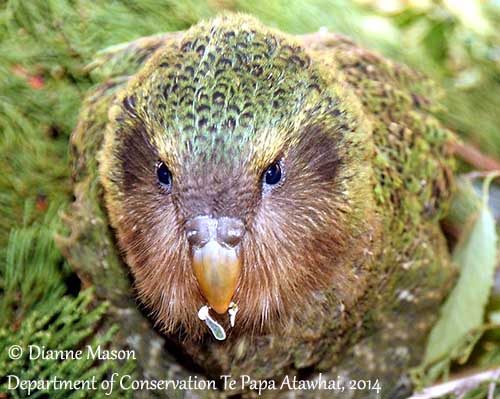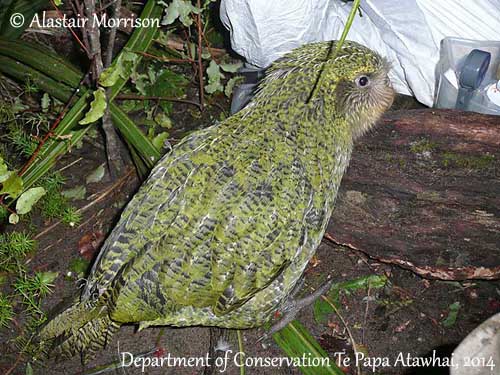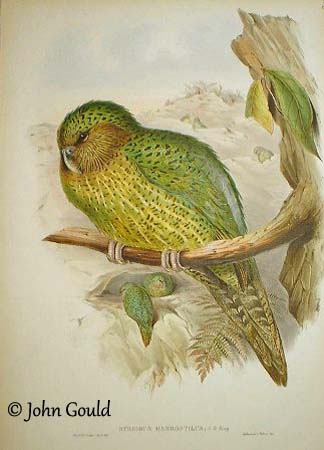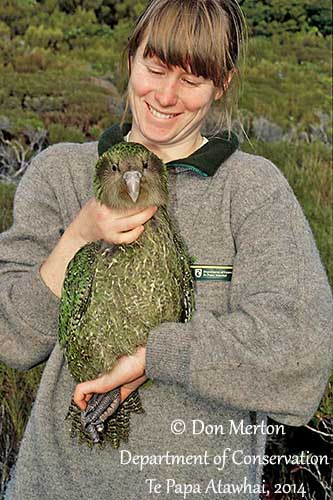
Fr: Strigops kakapo
Ang: Kakapo
Maori: Kakapo, Ka-ka-po
All: Kakapo
Esp: Kakapo
Ita: Kakapo
Nd: Kakapo
Sd: Kakapo
Photographers:
Dianne Mason
Alastair Morrison
Don Merton
Courtesy of Department of Conservation Te Papa Atawhai, 2014
Department of Conservation
Illustration:
John Gould: 1804-1881
Text by Nicole Bouglouan
Sources:
HANDBOOK OF THE BIRDS OF THE WORLD vol 4 by Josep del Hoyo-Andrew Elliott-Jordi Sargatal - Lynx Edicions - ISBN: 8487334229
PARROTS OF THE WORLD – An Identification Guide – by Joseph M. Forshaw – Princeton University Press – ISBN 0691092516
KNOW YOUR NEW ZEALAND BIRDS by Lynnette Moon - New Holland Publishers – ISBN: 1869660897
L’ENCYCLOPEDIE MONDIALE DES OISEAUX - Dr Christopher M. Perrins - BORDAS - ISBN: 2040185607
BirdLife International (BirdLife International)
Endangered flightless parrot sees highest population in 50 years after artificial insemination
New Zealand's rare kakapo parrot sees population boom
Wikipedia (Wikipedia, The Free Encyclopedia)
New Zealand bird status between 2008 and 2012
New Zealand birds and birding (Narena Olliver)
Kakapo
Strigops habroptilus
Psittaciformes Order – Strigopidae Family
INTRODUCTION:
The Kakapo is a Critically Endangered species with only 126 individuals, with at least 78 breeding adults. They have been translocated to four predator-free offshore islands, managed by the Department of Conservation.
It is sometimes called “owl parrot” with its flat owl-like face. This nocturnal bird is flightless. It uses a “lek” breeding system, which is another unique feature in Psittaciformes’ behaviour. The male produces deep, booming calls which can be heard over several kilometres. The Kakapo is vegetarian. It feeds on the ground and can walk over long distance at night.
They were formerly widespread in the beech forests of the South Island and throughout New Zealand. The introduction of mammalian predators led this species almost to extinction. The population is now slowly increasing, thanks to the translocation of the remaining birds to sanctuaries free of predators. The Kakapo is endemic to New Zealand.
DESCRIPTION OF THE BIRD:
Biometrics:
Length: 58-64 cm
Weight: M: 2-4 kg – F: 1-2,5 kg
The Kakapo’s plumage is downy and soft, and the green colour provides it good camouflage among the vegetation.
The adult has moss-green plumage with yellow and blackish-brown mottling on the upperparts, and more yellowish pattern below. The fairly long tail is barred greenish-yellow and brownish.
The owl-like face is yellowish-brown with narrow lemon-yellow supercilium. We can see long rictal bristles around the base of the bill.
The bill is pale blue-grey with conspicuous nostrils at upper base. The eyes are dark brown. The strong legs and feet are grey with paler soles.
Both sexes have similar plumage but the female is smaller than the male.
The juvenile is duller with browner face.

RANGE:
The Kakapo was formerly widespread on North, South and Stewart islands. The species occurs now on offshore predator-free islands, and survives on Codfish I, Maud I and Little Barrier I, and newly predator-free Chalky and Anchor Islands in Fiordland.
HABITAT:
The Kakapo occurs in forested islands, but formerly, it was living in a wide variety of habitat types such as Podocarp forests in lowlands, upland beech forests (Notophagus) and subalpine scrubland.
CALLS AND SONGS: SOUNDS BY XENO-CANTO
The Kakapo male produces deep, booming calls starting with short grunts like loud, wheezing calls, increasing in volume to series of echoing booms. The booming rate is as much as 15-16 times a minute, and may last several following hours.
These sounds are used to attract females to the lek.
Other sounds such as croaks, screams, mews and high-pitched “skraak” calls can be heard too, the latter being given by male and female.
BEHAVIOUR IN THE WILD:
The Kakapo is vegetarian. It feeds on leaves, buds, flowers, seeds, fruits, moss, bark, roots and bulbs found in subalpine scrub. The diet varies, depending on seasons.
The Kakapo uses its powerful bill to crush plant matter, and it often chews snow tussock grasses (Chionochloa), and munches the leaves still attached to the plant. While feeding, it uses the feet too to hold the food to the bill, in parrot-like feeding behaviour.
The Kakapo has nocturnal habits and is a solitary bird. It walks very well on the ground thanks to its strong legs and feet, through bush and tussock. The short wings are used to balance when it jumps. It climbs branches and trees too.
During the day, it roosts hidden among the dense vegetal cover. It is active at night for feeding.

During the breeding season, the Kakapo uses a lek for displaying and to attract a mate. The male makes a shallow depression in the earth, from where it produces its booming calls. These low-frequency sounds can be heard as far as 5 kilometres.
These bowls (also called “courts” or “arenas”) are usually kept clean prior to courtship displays which take place at night. One male may have up to 10 or more bowls linked by well-formed tracks.
While the male is booming, it rocks, walks backwards and slowly extends and flats the wings.
The female enters a lek and chooses a male. Following the copulation, she builds the nest alone.
The Kakapo is sedentary and flightless. It moves by walking on the ground and climbing branches in trees. It may perform some short glides from tree to another, but it always lands much lower than where it started.
REPRODUCTION OF THIS SPECIES:
The breeding season takes place between November and February. The Kakapo does not breed every year, but usually every 2-4 years, in years of good fruit abundance.
After mating, the female builds the nest alone in a burrow, in large rock crevice, between roots, under tussock or log. The scrape is sometimes lined with leaves, feathers and/or wood dust.
She lays 2-3 white eggs and incubates alone during one month. At hatching, the chicks are covered with white down. They are fed on regurgitated plant matter. They fledge about 3 ½ months after hatching. They reach their sexual maturity at 9-10 years of age.
The male does not take part in nesting duties.

PROTECTION / MENACES / STATUS:
The Kakapo was formerly hunted for its plumage and for consumption. The species was affected by hunting, but also by habitat loss due to forest clearance and destruction of bush for farming and agriculture.
But the Kakapo has been led close to extinction by introduced predators such as cats, rats and stoats. As ground-nesting species, eggs, chicks and incubating female were taken and killed by these predators.
The extinct giant Haast’s Eagle (Harpagornis moorei) was probably its only native predator.
The remaining birds have been translocated to offshore predator-free islands where they are managed by theDepartment of Conservation. Numbers are slowly increasing and the population is estimated at 126 birds with 78 breeding adults.
The species is currently listed as Critically Endangered with small population and restricted range.

Ros Cole (in DOC uniform) holding the 82 day old male Kakapo "Tiwai"
Codfish Island, June 1997
Update at
the bottom
Update August 2022
The population of Kakapo has now reached its highest level in decades, which represents a great achievement for the teams that have worked for this purpose.
Last year, numbers increased by 25% to a current total of 252 individuals (in 2002, there were only 82).
The breeding season was excellent, with 55 more chicks, thanks to several successful attempts at artificial insemination. According to the Department of Conservation, this practice is essential for a species that reproduces only every two or four years.
With help from the Kakapo Recovery Program established in 1995 and other conservation organizations, the population is beginning to recover.
Tane Davis who represents this program said: “Our goal is to increase their numbers to allow them to live freely in a natural environment”.